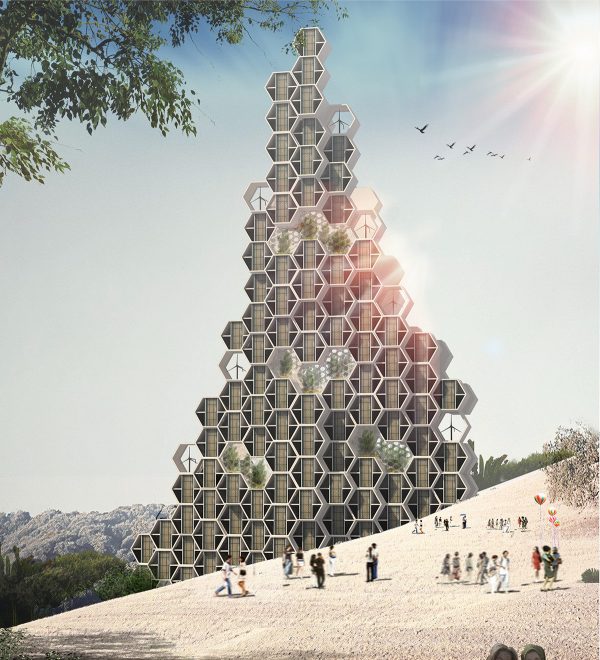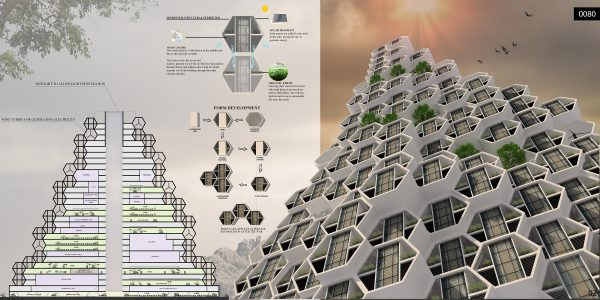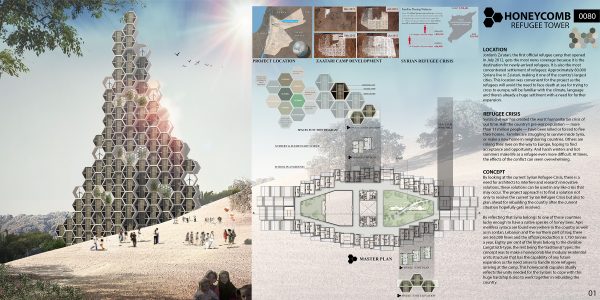2017 Skyscraper Competition
Editors’ Choice
Nael Badr, Noel Maestro, Hagar Elahmar
Qatar
LOCATION
Jordan’s Za’atari, the first official refugee camp that opened in July 2012, gets the most news coverage because it is the destination for newly-arrived refugees. It is also the most concentrated settlement of refugees: Approximately 80,000 Syrians live in Za’atari, making it one of the country’s largest cities. This location was convenient for the project as the refugees will avoid the need to face death at sea for trying to cross to Europe, will be familiar with the climate, language and there’s already a huge settlement with a need for further expansion.
REFUGEE CRISIS
Syria’s civil war has created the worst humanitarian crisis of our time. Half the country’s pre-war population — more than 11 million people — have been killed or forced to flee their homes. Families are struggling to survive inside Syria, or make a new home in neighboring countries. Others are risking their lives on the way to Europe, hoping to find acceptance and opportunity. And harsh winters and hot summers make life as a refugee even more difficult. At times, the effects of the conflict can seem overwhelming.
CONCEPT
By looking at the current Syrian Refugee Crisis, there is a need for architects to interfere and research innovative solutions, these solutions can be used in any like crisis that may occur. The project approach is to find a solution not only to resolve the current Syrian Refugee Crisis but also to plan ahead for rebuilding the country after the current situation hopefully gets resolved.
By reflecting that Syria belongs to one of those countries lucky enough to have a native species of honey bees. Apis mellifera syriaca are found everywhere in the country as well as in Jordan, Lebanon and the northern part of Iraq; there are 365,000 hives and the official production is 1,750 tonnes a year. Eighty per cent of the hives belong to the divisible Langstroth-type; the rest being the traditional types; the concept was to make a honeycomb like modular residential units structure that has the capability of any future expansion as the need arises to handle more refugees arriving at the camp. This honeycomb capsules reflects the unity needed for the Syrians to cope with this huge hardship & also to work together in rebuilding the country.
In order to provide a complete life style for the refugees three parks are introduced at different parts of the tower that looks to the outside and opened from both sides of the building to allow air circulation in addition to introducing at the core of the building educational facilities, market place, worship areas & healthcare facilities.
SUSTAINABILITY
A sustainable design approach was taken as this will educate the refugees about sustainability in both design and life; in this way it’s a chance that after the Syrian Crisis the sustainability factor will be present in the rebuilding phase.
The Units will be 3D printed and will reuse the refugee cabins in the manufacture process. The unit capsule itself will be divided in to two halves, the upper half will have an organic farm to help the residents in growing their own food while also reusing the grey water in the process and the lower half will have a vertical opening with louvers on the facade on both sides to act as a wind catcher for the unit below, and finally solar panels are used at the side of the units facing the sun in addition to wind turbines capsule to generate electricity.

















